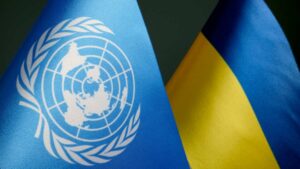
In January-August of this year, Ukrainian enterprises reduced imports of lead and lead products by 67.9% to $722 thousand ($9 thousand), imports of tin and tin products by 33.8% to $1.633 million ($208 thousand), but increased imports of zinc and zinc products by 10.1% to $28.775 million ($3.934 million).
Exports of aluminum and aluminum products in January-August this year decreased by 4.8% compared to the same period last year to $63.289 million ($8.201 million in August), lead and lead products increased by 13.6% to $9.866 million ($0.876 million), nickel and nickel products amounted to $201 thousand ($76 thousand), while in 8 months. 2022 it was $1.339 million.
Imports of tin and tin products fell by 33.5% to $3.312 million, while imports of zinc and zinc products decreased by 58.7% to $38.690 million.
Real GDP percentage changes over previous period in 2014-2023

Source: Open4Business.com.ua and experts.news

In January-August this year, Ukrainian companies reduced imports of nickel and products by 75.3% compared to the same period in 2022 to $11.038 million ($2.599 million in August), while aluminum and aluminum products increased by 17.8% to $243.990 million ($38.614 million).

Civilian casualties from February 24, 2022, after Russia launched a full-scale war against Ukraine, to September 10, 2023, totaled 27,149 (26,717 as of August 27), including 9,614 deaths (9,511), the Office of the UN High Commissioner for Human Rights (UN OHCHR) reported.
“The UN OHCHR considers that the actual number of civilian deaths or injuries is significantly higher, as many reports from locations where such incidents have occurred continue to require further confirmation, while information from some locations where fighting continues has been delayed,” the document said regarding the UN data.
This applies, for example, to such localities as Mariupol (Donetsk region), Lisichansk, Popasnaya and Severodonetsk (Luhansk region), where numerous civilian deaths or injuries have been reported.
According to confirmed UN figures, 4,461 men, 2,672 women, 289 boys and 236 girls were killed, while the gender of 29 children and 1,927 adults could not yet be ascertained.
Among the 17,535 injured, 516 boys and 378 girls were killed, while 286 children whose gender could not yet be determined.
Compared to August 27, five children have died and 14 others have been injured.
While the UN OHCHR casualty count summary was previously issued daily, and then only on weekdays, it became weekly from July 2022 and biweekly from the end of May 2023. This summary, like the previous one, provides data by month.
According to them, the UN recorded the deaths of 55 civilians in 10 days in September. In August, the number of new deaths reported dropped to 147 from 161 in July, 186 in June, 174 in May, 182 in April, 181 in March and 144 in February.
The deadliest month for civilians, the UN points out, remains March last year, with a minimum of 4,168 deaths. In April 2022, according to an OHCHR publication, the number of civilian deaths due to war fell to 823 in April, 550 in May, 429 in June and 386 in July. There were 375 deaths in the first five days of the war from February 24 to February 28, 340 in August last year, 408 in September, 310 in October, 188 in November, 206 in December and 201 in January this year.
The number of wounded in the 10 days of September was 237, compared with 565 in August, 688 in July, 679 in June, 685 in May, 492 in April, 592 in March, 457 in February, 538 in January this year, 617 in December and 541 in November last year. In October, the number of injuries dropped to 795 from 983 in September, when it was up from August’s 921. Prior to that the monthly number of wounded exceeded a thousand: July, 1,131; June, 1,109; May, 1,139; April, 1,896; March, 3,001. In the first five days of the war last February, 469 people were wounded.
The UN OHCHR specifies that since the beginning of September, explosive weapons have killed 54 people and injured 170 others, while mines and explosive remnants of war have killed one person and injured 16 (6%).
Government-controlled territories accounted for 79% of casualties in the first 10 days of September, according to the UN.
The summary traditionally states that the increase in figures to the previous summary should not be attributed solely to cases after August 27, as during this period the Office verified a number of cases from the previous days.
Source: https://www.ohchr.org/en/news/2023/09/ukraine-civilian-casualty-update-11-september-2023

Wall Street experts expect earnings of S&P 500 companies to increase in the current quarter after three quarters of annual decline, The Wall Street Journal writes.
This could create a more stable basis for the recovery of the US stock market, which has stalled recently. The S&P 500 is up nearly 17% year to date, but the index has ended in the red for four of the last six weeks.
The consensus among experts surveyed by FactSet is for S&P 500 earnings to rise 0.5% this quarter and 1.2% for the full year.
Analysts raised their forecasts for the current quarter in the first two months, something that hasn’t happened since the third quarter of 2021, said John Butters, chief earnings analyst at FactSet.
Earnings forecasts are at or near record levels across most segments of the S&P 500, including the IT, communications services and consumer goods companies.
The sub-indices of these segments in the S&P 500 are leading the gainers this year. Thus, the indicator of shares of IT companies has increased since the beginning of the year by 41%, communication services – 43%, manufacturers of consumer goods – 32%.
In recent days, analysts have raised earnings per share forecasts for industrial companies and utility providers to record highs, the WSJ notes. The industrials subindex of the S&P 500 is up 7.1% this year, while utilities are down 11%.
David Lefkowitz, head of US equities at UBS Global Wealth Management, expects the S&P 500 to be around 4,500 at the end of December this year and reach 4,700 by the end of June next year.
As of 17:00 Moscow time on Monday, the index value is 4476.37 points.
Lefkowitz expects the resumption of student loan payments, as well as high energy prices and mortgage rates, to keep the stock market down.

47% of Ukrainians perceive corruption as the biggest obstacle to the development of entrepreneurship in the country, according to a survey conducted by the Ilko Kucheriv Democratic Initiatives Foundation in cooperation with the Kyiv International Institute of Sociology on July 3-17, 2023.
“According to the survey conducted in July 2023, corruption is perceived by citizens as the biggest obstacle to the development of entrepreneurship in the country. This was noted by 47% of respondents. For comparison: 37% named the destruction caused by the war as the biggest obstacle, 36% – inadequate tax administration and control system, 36% – weak support from the state,” the report on the results of the study published on Monday on the official website of the Fund says.
As noted, “problems that directly depend on the quality of public administration occupy three of the top four positions that, according to Ukrainians, hinder the development of entrepreneurship. At the same time, the next most negative impact on entrepreneurship is the outflow of specialists and entrepreneurs abroad (29%) and the outflow of employees abroad (28%).”
Sociologists have recorded that corruption as an obstacle to entrepreneurship was mentioned somewhat more often in the East (55%) and less often in the West (43%) of the country. Similarly, critical attitudes toward tax control are noticeably increasing from the West (30%) to the East (43%). Respondents in the eastern (40%) and southern regions (33%) mentioned the outflow of specialists and entrepreneurs abroad more often than in the western (22%) and central regions (27%), which were less affected by the hostilities. The same situation is with the outflow of workers: it was mentioned more often in the east (37%) and south (31%) than in the west (25%) and center (24%).
“It is significant,” the report says, “that there is a distrust in society of domestic agents of post-war economic and infrastructure recovery. In particular, in July 2023, only 17.5% of respondents agreed with the opinion that state-owned Ukrainian companies and banks could effectively and without corruption carry out the country’s post-war recovery. The level of trust in Ukrainian private companies and banks is even lower – 8%.

Currently, large Western companies and banks (28%) and international financial organizations such as the IMF and the World Bank (19%) have the highest, but also low, levels of trust. Large non-Western companies and banks (China, UAE, Saudi Arabia) have the lowest level of trust – only 3% of respondents.
The survey was conducted face-to-face in all regions of Ukraine, except for the Autonomous Republic of Crimea, Donetsk, Luhansk, and Kherson regions. In Zaporizhzhia and Kharkiv regions, the survey was conducted in the territories controlled by the Government of Ukraine and not subject to hostilities. 2011 respondents aged 18 and older were interviewed.